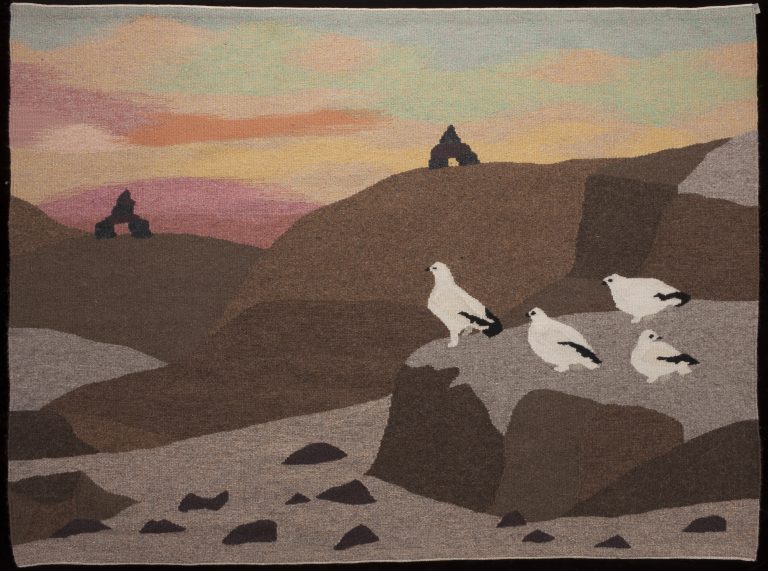Wherever possible, artists give their recollections of the work and the experience of creating it, or their reminiscences of the past or hopes for the future of memory making…they gently extend the lives of their memories into every subsequent moment. The voices and memories of the artists, their families, friends, elders, young Inuit and Inuit artists reflect on the work and what it stirs in them. For works where the artists are no longer living, or no longer known, their words are recounted by families, drawn from archives, or interpreted by a new generation of Inuit: Elders and community members throughout the South as well as the North—often connected through the modern memory-making vehicle of Facebook.
Highlights of the exhibit are rare pieces from Taloyoak, such as natural dye collages of which only 24 were ever created, natural dye animals, macramé pieces hung on caribou antler supports, and other experimental pieces which have never been exhibited before. Wall hangings by artists well-known and not widely known are grouped by connections to one another and include applique, embroidery, and weavings. While several well-known artists are exhibited, artists who were once known or less well-known to those outside their communities are also included in order to explore the breadth of experiences, memories, and histories of women across Inuit Nunangat.
Also included are pieces unique and rare for certain well-known artists, highlighting the breadth of their vision, creativity, and imagination: a true celebration of the unexpected. These include a beaded collar by Marion Tuu’luq created as a test project in the 1960s, a stuffed embroidered Duck in Flight by Winnie Tatya, and a Natural Dye Cape created by Selena Tucktoo, who is well-known for recording and developing photographic memories of her community of Taloyoak as part of Darkroom project.
The central platform which carries traditional, experimental, and contemporary clothing reflects the shape of the hood of a beaded amauti, with inspiration taken from those created in Igluuligaarjuk and documented in archival photographs held in museum collections and those shared by families. Cases shaped like ulus holding smaller works such as toy animals, dolls, and natural dye wools, remind us of the talent Inuit women have always had to create the clothing necessary for their families’ survival out of animal skin. While they were responsible for keeping their families warm, they carried more than the collective cultural memories of necessary technical skills, but also memories of connections to the land, animals, and ancestors which they creatively interpreted in fur applique, beadwork, and fringework which held deep spiritual and personal significance.
While these items are truly both art and craft, they also remind us of the the entangled history of Inuit and their colonizers, with whom they once traded to acquire materials for adornment, but whose culture they were quickly forced to adopt, including the craft economy which promised economic security. As Janet Kigusiuq’s daughter mentioned in conversation, “my mom loved to sew, but she made a lot because she knew she needed money to support the family.”
Themes that run through the exhibit include: collective cultural values and memories, spiritual and cosmological beliefs, oral traditions – stories transmitting myths, historical events, personal experiences, and transformation, artistic creativity, and innovation, genetic memory, and the role of women as memory keepers—the role of memories formed in the womb and during childbirth, memories produced through the imposition of a foreign culture, and how the unexpected can be understood through memories contained in the land, weather, animals, and spiritual realm.
Some of the themes in the work will challenge the viewer to understand their own connections to the issues faced by women in the North, such as that addressed by Chantelle Andersen in her Embroidered Amauti. Chantelle speaks of a loss of Nunatsiavummiut culture and how when she sought a mentor or even an example from which to learn how to make traditional amautis, she was struck by the stark realization that the Nunatsiavummiut had been stripped of much of their culture and she was unable to find even one example from which to draw inspiration.
Maureen Gruben also explores the fragility of northern species such as the polar bear and the need for the healing of Inuit people through reconnection to land, memory, and traditions in the midst of an onslaught of colonial pressures.
While referring explicitly inward to localised acts of hunting, gathering, and communal preparation and sharing, the work, equally, extends decisively outward, exploring new visual languages that offer compelling and often urgent global associations and forging critical links between life in the Western Arctic and global environmental and cultural concerns.
Not to be thought of chronologically or as a survey, it is instead a group of works connected through a common cultural thread and of shared experience as Inuit women. It is to be, as described by contributor Tapisa Kilabuk, as a “living, breathing organism,” one that will inspire and provoke new memories and encourage connections to the women who touched the fibres with their own hands. It is in essence meant to be experienced as the art of living memory.

